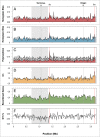Impermanence of bacterial clones
- PMID: 26195749
- PMCID: PMC4517237
- DOI: 10.1073/pnas.1501724112
Impermanence of bacterial clones
Abstract
Bacteria reproduce asexually and pass on a single genome copied from the parent, a reproductive mode that assures the clonal descent of progeny; however, a truly clonal bacterial species is extremely rare. The signal of clonality can be interrupted by gene uptake and exchange, initiating homologous recombination that results in the unique sequence of one clone being incorporated into another. Because recombination occurs sporadically and on local scales, these events are often difficult to recognize, even when considering large samples of completely sequenced genomes. Moreover, several processes can produce the appearance of clonality in populations that undergo frequent recombination. The rates and consequences of recombination have been studied in Escherichia coli for over 40 y, and, during this time, there have been several shifting views of its clonal status, population structure, and rates of gene exchange. We reexamine the studies and retrace the evolution of the methods that have assessed the extent of DNA flux, largely focusing on its impact on the E. coli genome.
Keywords: E. coli; clonality; genome evolution; homologous exchange; recombination.
Conflict of interest statement
The authors declare no conflict of interest.
Figures

References
-
- Maynard Smith J. The Evolution of Sex. Cambridge Univ Press; Cambridge, UK: 1978.
-
- Barton NH, Charlesworth B. Why sex and recombination? Science. 1998;281(5385):1986–1990. - PubMed
-
- Lynch M, Bürger R, Butcher D, Gabriel W. The mutational meltdown in asexual populations. J Hered. 1993;84(5):339–344. - PubMed
-
- Redfield RJ. Do bacteria have sex? Nat Rev Genet. 2001;2(8):634–639. - PubMed
MeSH terms
Grants and funding
LinkOut - more resources
Full Text Sources
Other Literature Sources

